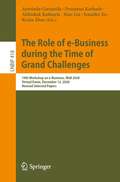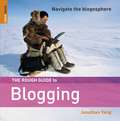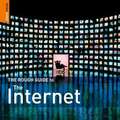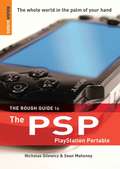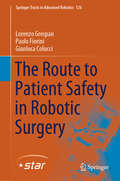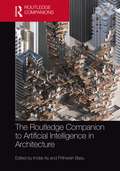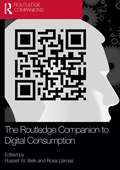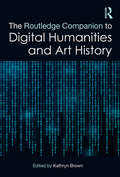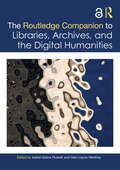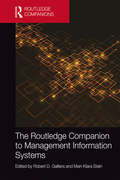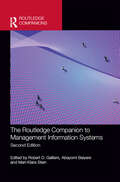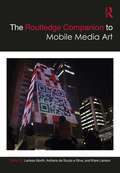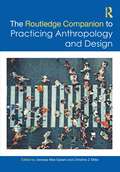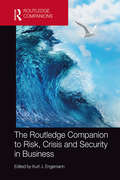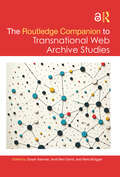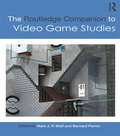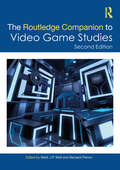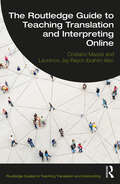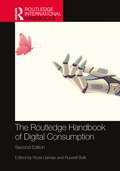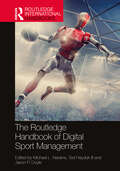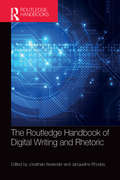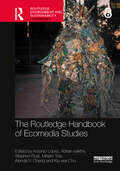- Table View
- List View
The Role of e-Business during the Time of Grand Challenges: 19th Workshop on e-Business, WeB 2020, Virtual Event, December 12, 2020, Revised Selected Papers (Lecture Notes in Business Information Processing #418)
by Xiao Liu Jennifer Xu Aravinda Garimella Prasanna Karhade Abhishek Kathuria Kexin ZhaoThis book constitutes revised selected papers from the 19th Workshop on e-Business, WeB 2020, which took place virtually on December 12, 2020.The purpose of WeB is to provide a forum for researchers and practitioners to discuss findings, novel ideas, and lessons learned to address major challenges and map out the future directions for e-Business. The WeB 2020 theme was “The Role of e-Business during the Time of Grand Challenges.” The 12 papers included in this volume were carefully reviewed and selected from a total of 24 submissions. The contributions are organized in topical sections as follows: Cybersecurity and COVID-19 challenges; digital platforms; and managing human factors in e-business.
The Rough Guide to Blogging
by Jonathan YangThe Rough Guide to Blogging is the ultimate reference for all things weblog. It takes you into the blogosphere, from blogging's early history and where it is today, to the future of blogs and their social and cultural impact. This book will help you to discover the greatest blogs on the web and to understand newsreaders and RSS. Whether you want to start your own blog or contribute to an existing one, this guide will teach you everything you'll need to know. Chapters include: Creating a Blog, Blog Design, Advanced Blogging, Audio and Video, Podcasting, Blogging for Money, Corporate Blogging plus much, much more. Whether you're an experienced blogger or just getting started, this is the right book for you.
The Rough Guide to eBay
by Ian PeelThe Rough Guide to eBay will transform you into a master trader at the world's biggest marketplace. Whether you're new to online auctions or you're angling to become a PowerSeller, you'll find all the expert advice you need. Buying Top bidding tactics to help you bag the best bargains, including sniping tools and more, Selling From getting the highest price from individual auctions to setting up a store, Payments Get the most from PayPal, the currency of eBay, Security The low-down on scams, rules, payments, insurance and legal issues, The Story The history, legends and subsidiaries of the world's greatest website, There's far more to eBay than meets the eye. The Rough Guide to eBay reveals all.
The Rough Guide to the Internet
by Peter Buckley Duncan ClarkWritten in plain English, this book covers everything from getting online for the first time to newsfeeds, Internet telephony and advanced tips and tricks guaranteed to turn casual surfers into Net gurus. This fully revised guide covers all the latest sites and crazes, including Skype, blogging, myspace and other social networks and online video. Whether you've never sent an email or you just want to keep up with the latest developments, this is the book for you.
The Rough Guide to the Play Station Portable
by Nicholas Gilewicz Sean MahoneyThe Rough Guide to the PSP is the ultimate handbook to Sony's hugely successful hand-held games console. From the basic buying and operating instructions to downloading and listening to music, this guide helps the reader to understand the technical processes of tweaking the PSP and to perform operations never dreamed of by Sony. It explains how to: Find the right model and get the best deal Explore the best online sites and forums Play movies, music, and games with the Universal Media Disc Fully exploit the PSP's WiFi functionality Downgrade firmware and run homebrew applications Use emulators to play classic games Maximize the potential of the memory stick Extend your PSP with software and hardware accessories Plus much, much more. . . Whether you're an experienced gamer or just getting started, this is the book for you.
The Route to Patient Safety in Robotic Surgery (Springer Proceedings in Advanced Robotics #126)
by Lorenzo Grespan Paolo Fiorini Gianluca ColucciThe introduction of a new technology in a consolidated field has the potential to disrupt usual practices and create a fertile ground for errors. An example is robotic surgery that is now used in most surgical specialties, pushed by technology developers and enthusiastic surgeons. To analyze the potential impact of robotic surgery on patient safety, a consortium of major European Universities started the project SAFROS whose findings are summarized and further elaborated in the three parts of this book. Part one describes safety in complex systems such as surgery, how this may disrupt the traditional surgical workflow, how safety can be monitored, and the research questions that must be posed. Part two of the book describes the main findings of this research, by identifying the risks of robotic surgery and by describing where its ancillary technologies may fail. This part addresses features and evaluation of anatomic imaging and modeling, actions in the operating room, robot monitoring and control, operator interface, and surgical training. Part three of the book draws the conclusions and offers suggestions on how to limit the risks of medical errors. One possible approach is to use automation to monitor and execute parts of an intervention, thus suggesting that robotics and artificial intelligence will be major elements of the operating room of the future.
The Routledge Companion to Artificial Intelligence in Architecture
by Imdat As and Prithwish BasuProviding the most comprehensive source available, this book surveys the state of the art in artificial intelligence (AI) as it relates to architecture. This book is organized in four parts: theoretical foundations, tools and techniques, AI in research, and AI in architectural practice. It provides a framework for the issues surrounding AI and offers a variety of perspectives. It contains 24 consistently illustrated contributions examining seminal work on AI from around the world, including the United States, Europe, and Asia. It articulates current theoretical and practical methods, offers critical views on tools and techniques, and suggests future directions for meaningful uses of AI technology. Architects and educators who are concerned with the advent of AI and its ramifications for the design industry will find this book an essential reference.
The Routledge Companion to Digital Consumption (Routledge Companions in Business, Management and Accounting)
by Russell W. Belk Rosa LlamasThe first generation that has grown up in a digital world is now in our university classrooms. They, their teachers and their parents have been fundamentally affected by the digitization of text, images, sound, objects and signals. They interact socially, play games, shop, read, write, work, listen to music, collaborate, produce and co-produce, search and browse very differently than in the pre-digital age. Adopting emerging technologies easily, spending a large proportion of time online and multitasking are signs of the increasingly digital nature of our everyday lives. Yet consumer research is just beginning to emerge on how this affects basic human and consumer behaviours such as attention, learning, communications, relationships, entertainment and knowledge. The Routledge Companion to Digital Consumption offers an introduction to the perspectives needed to rethink consumer behaviour in a digital age that we are coming to take for granted and which therefore often escapes careful research and reflective critical appraisal.
The Routledge Companion to Digital Humanities and Art History (Routledge Art History and Visual Studies Companions)
by Kathryn BrownThe Routledge Companion to Digital Humanities and Art History offers a broad survey of cutting-edge intersections between digital technologies and the study of art history, museum practices, and cultural heritage. The volume focuses not only on new computational tools that have been developed for the study of artworks and their histories but also debates the disciplinary opportunities and challenges that have emerged in response to the use of digital resources and methodologies. Chapters cover a wide range of technical and conceptual themes that define the current state of the field and outline strategies for future development. This book offers a timely perspective on trans-disciplinary developments that are reshaping art historical research, conservation, and teaching. This book will be of interest to scholars in art history, historical theory, method and historiography, and research methods in education.
The Routledge Companion to Global Internet Histories (Routledge Media and Cultural Studies Companions)
by Mark Mclelland Gerard GogginThe Routledge Companion to Global Internet Histories brings together research on the diverse Internet histories that have evolved in different regions, language cultures and social contexts across the globe. While the Internet is now in its fifth decade, the understanding and formulation of its histories outside of an anglophone framework is still very much in its infancy. From Tunisia to Taiwan, this volume emphasizes the importance of understanding and formulating Internet histories outside of the anglophone case studies and theoretical paradigms that have thus far dominated academic scholarship on Internet history. Interdisciplinary in scope, the collection offers a variety of historical lenses on the development of the Internet: as a new communication technology seen in the context of older technologies; as a new form of sociality read alongside previous technologically mediated means of relating; and as a new media "vehicle" for the communication of content.
The Routledge Companion to Libraries, Archives, and the Digital Humanities (Routledge Companions to the Digital Humanities)
by Isabel Galina Russell Glen Layne-WortheyThe Routledge Companion to Libraries, Archives, and the Digital Humanities covers a wide range of issues encountered in the world’s libraries and archives as they continue to expand their support of, and direct engagement in, Digital Humanities (DH) research and teaching. In addition to topics related to the practice of librarianship, and to libraries and archives as DH-friendly institutions, we address issues of importance to library and archives workers themselves: labour, sustainability, organisation and infrastructure, and focused professional practices that reflect the increasingly important role of librarians and archivists as active research partners. One of the central motifs of this book is that the “two” fields—DH, on the one hand, and the library, archival, and information sciences on the other—are in fact deeply intertwined, productively interdependent, and mutually reinforcing. We place these on an equal footing, considering how they coexist and collaborate in equal partnership.This Companion will be of interest to DH practitioners and theorists, especially those who work in libraries and archives, and those who work with them. Likewise, “non-DH” (or “not-yet-DH”) library and archival administrators, reference and public service librarians, cataloguers, and even those who work primarily with the tangible collections will find here echoes and implications of the most venerable traditions and practices of our shared profession.The Introduction of the book is free-to-view at https://www.book2look.com/book/hpV4zdnW6q.Chapter 14 of this book is freely available as a downloadable Open Access PDF at http://www.taylorfrancis.com under a Creative Commons Attribution-Non Commercial-No Derivatives (CC-BY-NC-ND) 4.0 license.Chapter 17 of this book is freely available as a downloadable Open Access PDF at http://www.taylorfrancis.com under a Creative Commons Attribution-Non Commercial-No Derivatives (CC-BY-NC-ND) 4.0 license.Chapter 8 and 18 will be made Open Access.
The Routledge Companion to Management Information Systems (Routledge Companions in Business, Management and Accounting)
by Robert D. Galliers Mari-Klara SteinThe field of Information Systems has been evolving since the first application of computers in organizations in the early 1950s. Focusing on information systems analysis and design up to and including the 1980s, the field has expanded enormously, with our assumptions about information and knowledge being challenged, along with both intended and unintended consequences of information technology. This prestige reference work offers students and researchers a critical reflection on major topics and current scholarship in the evolving field of Information Systems. This single-volume survey of the field is organized into four parts. The first section deals with Disciplinary and Methodological Foundations. The second section deals with Development, Adoption and Use of MIS – topics that formed the centrepiece of the field of IS in the last century. The third section deals with Managing Organizational IS, Knowledge and Innovation, while the final section considers emerging and continuing issues and controversies in the field – IS in Society and a Global Context. Each chapter provides a balanced overview of current knowledge, identifying issues and discussing relevant debates. This prestigious book is required reading for any student or researcher in Management Information Systems, academics and students covering the breadth of the field, and established researchers seeking a single-volume repository on the current state of knowledge, current debates and relevant literature.
The Routledge Companion to Management Information Systems (Routledge Companions in Business, Management and Marketing)
by Robert D. Galliers Mari-Klara Stein Abayomi BaiyereThe field of information systems has been evolving since the first application of computers in organizations in the early 1950s. Focusing on information systems analysis and design up to and including the 1980s, the field has expanded enormously, with our assumptions about information and knowledge being challenged, along with both intended and unintended consequences of information technology.This second edition takes stock of the progress made in recent years and presents a forward-looking perspective that can help to shape future scholarly conversations both in the field of information systems but also in cognate fields where information technology is having profound effects. With the advances in digital technology, such as artificial intelligence, the Internet of Things, cloud computing, blockchain, green tech and the like, we herald a digital era and can envision a shift and a need for new logics – “new ways of thinking” and new ways of engaging with digital technology now and in the near future. As compared to the four themes in the previous edition, this book introduces a fifth theme, “Digital Phenomena”, to specifically attend to contemporary issues and what is a pertinent agenda for future research. This prestige reference work offers students and researchers a critical reflection on major topics and current scholarship in this evolving field, with each chapter providing a balanced overview of current knowledge, identifying issues and discussing relevant debates.This book is required reading for any student or researcher concerned not just with the broad - and expanding - field of management information systems per se but all those in cognate disciplines interested in the impacts, management and use of modern information technologies in organizations and modern society, whether it be strategy, organizational behaviour, marketing, sociology or the like. This single-volume repository deals not just with the current state of knowledge, the current debates and the extant literature, but also with questions concerning emerging management concerns and implications of the fast-changing world of digital technologies.
The Routledge Companion to Mobile Media Art (Routledge Media and Cultural Studies Companions)
by Larissa HjorthIn this companion, a diverse, international and interdisciplinary group of contributors and editors examine the rapidly expanding, far-reaching field of mobile media as it intersects with art across a range of spaces—theoretical, practical and conceptual. As a vehicle for—and of—the everyday, mobile media is recalibrating the relationship between art and digital networked media, and reshaping how creative practices such as writing, photography, video art and filmmaking are being conceptualized and practised. In exploring these innovations, The Routledge Companion to Mobile Media Art pulls together comprehensive, culturally nuanced and interdisciplinary approaches; considerations of broader media ecologies and histories and political, social and cultural dynamics; and critical and considered perspectives on the intersections between mobile media and art. This book is the definitive publication for researchers, artists and students interested in comprehending all the various aspects of mobile media art, covering digital media and culture, internet studies, games studies, anthropology, sociology, geography, media and communication, cultural studies and design.
The Routledge Companion to Practicing Anthropology and Design
by Jenessa Mae Spears Christine Z MillerThe Routledge Companion to Practicing Anthropology and Design provides a comprehensive overview of the history of the relationship between these two fields and their current state, outlining key concepts and current debates as well as positing directions for future practice and research. Bringing together original work from a diverse group of established and emerging professionals, this volume joins a wider conversation about the trajectory of this transdisciplinary movement inspired by the continuing evolution of anthropology and design as they have adapted to accelerating and unpredictable conditions in arenas that span sectors, economies, socio-cultural groups, and geographies. It homes in on both the growing convergence and tensions between them while exploring how individuals from both fields have found ways of mixing, experimenting, and evolving theory and new forms of practice, highlighting the experimental theories and practices their transdisciplinarity has generated.The Routledge Companion to Practicing Anthropology and Design is a valuable reference tool for practitioners, scholars, and upper-level students in the fields of anthropology and design as well as related disciplines.
The Routledge Companion to Risk, Crisis and Security in Business (Routledge Companions in Business, Management and Accounting)
by Kurt J. EngemannAware that a single crisis event can devastate their business, managers must be prepared for the worst from an expansive array of threats. The Routledge Companion to Risk, Crisis and Security in Business comprises a professional and scholarly collection of work in this critical field. Risks come in many varieties, and there is a growing concern for organizations to respond to the challenge. Businesses can be severely impacted by natural and man-made disasters including: floods, earthquakes, tsunami, environmental threats, terrorism, supply chain risks, pandemics, and white-collar crime. An organization’s resilience is dependent not only on their own system security and infrastructure, but also on the wider infrastructure providing health and safety, utilities, transportation, and communication. Developments in risk security and management knowledge offer a path towards resilience and recovery through effective leadership in crisis situations. The growing body of knowledge in research and methodologies is a basis for decisions to safeguard people and assets, and to ensure the survivability of an organization from a crisis. Not only can businesses become more secure through risk management, but an effective program can also facilitate innovation and afford new opportunities. With chapters written by an international selection of leading experts, this book fills a crucial gap in our current knowledge of risk, crisis and security in business by exploring a broad spectrum of topics in the field. Edited by a globally-recognized expert on risk, this book is a vital reference for researchers, professionals and students with an interest in current scholarship in this expanding discipline.
The Routledge Companion to Transnational Web Archive Studies (Routledge Companions to the Digital Humanities)
by Susan Aasman Niels Brügger Anat Ben-DavidThe Routledge Companion to Transnational Web Archive Studies explores the untapped potential of web archives for researching transnational digital history and communication. It covers cross- border, cross- collection, and cross- institutional examination of web archives on a global scale.This comprehensive collaborative work, emerging from the WARCnet research network, presents an exploration of the ways web archive research can transcend technological and legal challenges to allow for new comparative, transnational studies of the web’s pasts, and of global events. By combining interdisciplinary work and fostering collaboration between web archivists and researchers, the book provides readers with cutting- edge approaches to analyzing digital cultural heritage across countries. The book contains concrete examples on how to research national web domains through a transnational perspective; provides case studies with grounded explorations of the COVID- 19 crisis as a distinctly transnational event captured by web archives; offers methodological considerations while unpacking techniques and skill sets for conducting transnational web archive research; and critically engages the politics and power dynamics inherent to web archives as institutionalised collections.The Routledge Companion to Transnational Web Archive Studies is an essential read for graduate students and scholars from internet and media studies, cultural studies, history, and digital humanities. It will also appeal to web archiving practitioners, including librarians, web curators, and IT developers.
The Routledge Companion to Video Game Studies (Routledge Media and Cultural Studies Companions)
by Bernard Perron Mark J. P. WolfThe number of publications dealing with video game studies has exploded over the course of the last decade, but the field has produced few comprehensive reference works. The Routledge Companion to Video Game Studies, compiled by well-known video game scholars Mark J. P. Wolf and Bernard Perron, aims to address the ongoing theoretical and methodological development of game studies, providing students, scholars, and game designers with a definitive look at contemporary video game studies. Features include: comprehensive and interdisciplinary models and approaches for analyzing video games; new perspectives on video games both as art form and cultural phenomenon; explorations of the technical and creative dimensions of video games; accounts of the political, social, and cultural dynamics of video games. Each essay provides a lively and succinct summary of its target area, quickly bringing the reader up-to-date on the pertinent issues surrounding each aspect of the field, including references for further reading. Together, they provide an overview of the present state of game studies that will undoubtedly prove invaluable to student, scholar, and designer alike.
The Routledge Companion to Video Game Studies (Routledge Media and Cultural Studies Companions)
by Bernard Perron Mark J. P. WolfA definitive guide to contemporary video game studies, this second edition has been fully revised and updated to address the ongoing theoretical and methodological development of game studies. Expertly compiled by well-known video game scholars Mark J. P. Wolf and Bernard Perron, the Companion includes comprehensive and interdisciplinary models and approaches for analyzing video games, new perspectives on video games both as an art form and cultural phenomenon, explorations of the technical and creative dimensions of video games, and accounts of the political, social, and cultural dynamics of video games. Brand new to this second edition are chapters examining topics such as preservation; augmented, mixed, and virtual reality; eSports; disability; diversity; and identity, as well as a new section that specifically examines the industrial aspects of video games including digital distribution, game labor, triple-A games, indie games, and globalization. Each essay provides a lively and succinct summary of its target area, quickly bringing the reader up-to-date on the pertinent issues surrounding each aspect of the field, including references for further reading. A comprehensive overview of the present state of video game studies that will undoubtedly prove invaluable to students, scholars, and game designers alike.
The Routledge Guide to Teaching Translation and Interpreting Online (Routledge Guides to Teaching Translation and Interpreting)
by Cristiano Mazzei Laurence Jay-Rayon Ibrahim AiboRoutledge Guides to Teaching Translation and Interpreting is a series of practical guides to key areas of translation and interpreting for instructors, lecturers, and course designers. The Routledge Guide to Teaching Translation and Interpreting Online is for educators of translation and interpreting teaching online in a variety of curricular combinations: fully online, partially online, hybrid, multimodal, or face-to-face with online components. Offering suggestions for the development of curriculum and course design in addition to online tools that can be used in skill-building activities, and adaptable to specific instructional needs, this textbook is suitable for both multilingual and language-specific classes. Fully comprehensive, the book addresses the tenets and importance of process-oriented pedagogy for students of translation and interpreting, best practices in online curriculum and course design, instructor online presence, detailed illustrations of specific online assignments, the importance of regular and timely feedback, and teaching across the online translation and interpreting (T&I) curriculum. Written by two experienced translators, interpreters, and scholars who have been teaching online for many years and in various settings, this book is an essential guide for all instructors of translation and interpreting as professional activities and academic disciplines.
The Routledge Handbook of Digital Consumption (Routledge International Handbooks)
by Rosa Llamas Russell BelkSince the publication of the ground-breaking first edition, there has been an exponential growth in research and literature about the digital world and its enormous potential benefits and threats. Fully revised and updated, this new edition brings together an expertly curated and authoritative overview of the impact and emerging horizons of digital consumption. Divided into sections, it addresses key topics including digital entertainment, self-representation, communication, Big Data, digital spirituality, online surveillance, and algorithmic advertising. It explores developments such as consumer data collection techniques, peer-to-peer payment systems, augmented reality, and AI-enhanced consumer well-being, as well as digital transgression, secrecy, crypto-currencies, NFTs, and cultural concerns such as the spread of conspiracy theories and fake news. From digital influencers, digital nomads, and digital neo-tribalism to robots and cyborgs, it explores existences that blur boundaries between humans and machines, reality and the metaverse, and the emerging "technoculture" – a state of all-encompassing digital being. This unique volume is an essential resource for scholars, practitioners, and policy makers, and will continue to provide a new generation of readers with a deep understanding of the universe of digital consumption.
The Routledge Handbook of Digital Sport Management (Routledge International Handbooks)
by Michael L. Naraine Ted Hayduk Iii Jason P. DoyleThe Routledge Handbook of Digital Sport Management provides students, researchers, and practitioners with a contemporary roadmap of the impact of digital technologies in sport management, at all levels and in all sectors, in a global context. Divided into three sections addressing digital transformations, digital tools, and emerging digital issues, this book explores the impact of digital technology in the core functional areas of sport management, such as sponsorship, event management, and human resources. It introduces essential digital innovations such as esports, social media, VR, wearables, analytics, and artificial intelligence, and examines the debates and issues that are likely to shape and transform sport business over the next decade. The only book to survey the full sweep of digital sport management, this book is an essential reference for all serious students of sport business and management, any researcher working in the nexus of sport business and digital, and all managers, policy-makers or associated professionals working in the sport industry.
The Routledge Handbook of Digital Writing and Rhetoric (Routledge Handbooks in Communication Studies)
by Jonathan Alexander and Jacqueline RhodesThis handbook brings together scholars from around the globe who here contribute to our understanding of how digital rhetoric is changing the landscape of writing. Increasingly, all of us must navigate networks of information, compose not just with computers but an array ofmobile devices, increase our technological literacy, and understand the changing dynamics of authoring, writing, reading, and publishing in a world of rich and complex texts. Given such changes, and given the diverse ways in which younger generations of college students are writing, communicating, and designing texts in multimediated, electronic environments, we need to consider how the very act of writing itself is undergoing potentially fundamental changes. These changes are being addressed increasingly by the emerging field of digital rhetoric, a field thatattempts to understand the rhetorical possibilities and affordances of writing, broadly defined, in a wide array of digital environments. Of interest to both researchers and students, this volume provides insights about the fields of rhetoric, writing, composition, digital media, literature, and multimodal studies.
The Routledge Handbook of Ecomedia Studies (Routledge Environment and Sustainability Handbooks)
by Miriam Tola Stephen Rust Adrian Ivakhiv Alenda Y. Chang Antonio López Kiu-Wai ChuThe Routledge Handbook of Ecomedia Studies gathers leading work by critical scholars in this burgeoning field. Redressing the lack of environmental perspectives in the study of media, ecomedia studies asserts that media are in and about the environment, and environments are socially and materially mediated. The book gives form to this new area of study and brings together diverse scholarly contributions to explore and give definition to the field. The Handbook highlights five critical areas of ecomedia scholarship: ecomedia theory, ecomateriality, political ecology, ecocultures, and eco-affects. Within these areas, authors navigate a range of different topics including infrastructures, supply and manufacturing chains, energy, e-waste, labor, ecofeminism, African and Indigenous ecomedia, environmental justice, environmental media governance, ecopolitical satire, and digital ecologies. The result is a holistic volume that provides an in-depth and comprehensive overview of the current state of the field, as well as future developments. This volume will be an essential resource for students, educators, and scholars of media studies, cultural studies, film, environmental communication, political ecology, science and technology studies, and the environmental humanities.
The Routledge Handbook of Ecomedia Studies (Routledge Environment and Sustainability Handbooks)
by Miriam Tola Stephen Rust Adrian Ivakhiv Alenda Y. Chang Antonio López Kiu-Wai ChuThe Routledge Handbook of Ecomedia Studies gathers leading work by critical scholars in this burgeoning field. Redressing the lack of environmental perspectives in the study of media, ecomedia studies asserts that media are in and about the environment, and environments are socially and materially mediated.The book gives form to this new area of study and brings together diverse scholarly contributions to explore and give definition to the field. The Handbook highlights five critical areas of ecomedia scholarship: ecomedia theory, ecomateriality, political ecology, ecocultures, and eco-affects. Within these areas, authors navigate a range of different topics including infrastructures, supply and manufacturing chains, energy, e-waste, labor, ecofeminism, African and Indigenous ecomedia, environmental justice, environmental media governance, ecopolitical satire, and digital ecologies. The result is a holistic volume that provides an in-depth and comprehensive overview of the current state of the field, as well as future developments.This volume will be an essential resource for students, educators, and scholars of media studies, cultural studies, film, environmental communication, political ecology, science and technology studies, and the environmental humanities.The Open Access version of this book, available at www.taylorfrancis. com, has been made available under a Creative Commons Attribution-Non Commercial-No Derivatives (CC-BY-NC-ND) 4.0 license. Deep gratitude for the generous support of those institutions that provided funding to enable this volume to be available simultaneously in print and open access: University of Oregon Libraries Open Access Publishing Award, Frank J. Guarini School of Busi-ness at John Cabot University, University of Vermont Humanities Center, University of California Santa Barbara, University of Lausanne, and School of Humanities at Nanyang Technological University.
